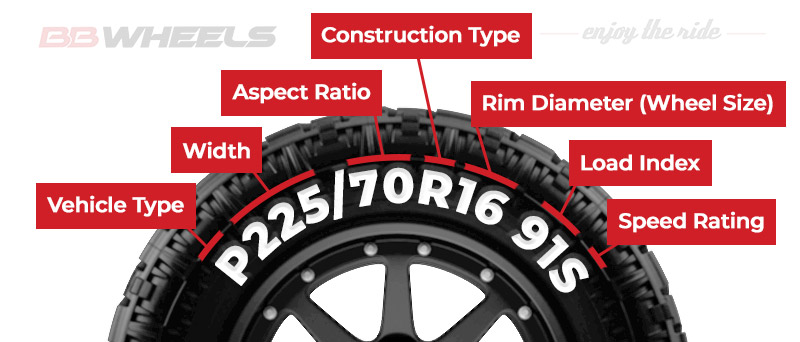Understanding Tire Sidewall Ratings: What Do They Mean for You?
Posted by BB Wheels on 18th Sep 2023

Understanding Tire Sidewall Ratings: What Do They Mean for You?
When it comes to your vehicle, few components are as essential as your tires. They're literally where the rubber meets the road. Yet, the alphanumeric soup on the sidewall of your tire might seem like a cryptic code. For the uninitiated, tire ratings can seem confusing, if not intimidating. However, understanding these ratings can provide valuable insights into tire performance, safety, and compatibility.
Here at BB Wheels, we specialize in aftermarket wheels and tires. And we want to help you make an informed decision when choosing new tires for your vehicle. Let’s dive right in and decode the mystery of tire ratings.
Tire Size
When it comes to tire size, you'll typically see a series of letters and numbers printed on the sidewall, like "P215/65R15" or "LT235/75R15." These figures are not just random numbers; they tell you a lot about the tire's specifications. Here’s what each segment means:
- P: Denotes passenger vehicle tire.
- LT: Stands for 'Light Truck,' and these tires are designed to carry more weight and handle off-road conditions better than standard passenger tires.
- 215 or 235: The width of the tire in millimeters.
- 65 or 75: The aspect ratio, or the height of the sidewall as a percentage of the tire's width.
- R: Radial construction, indicating how the internal ply cords are oriented.
- 15: Diameter of the wheel in inches.
Knowing the size is crucial for ensuring the tire fits your vehicle and meets your driving needs. But there's more to tire ratings than just size.
Deciphering Load Index and Speed Ratings
Once you've got a grip on tire size, the next crucial elements to understand are the Load Index and Speed Rating. These are usually found right after the tire size and often formatted as a pair like "95V." Comprehending these numbers is pivotal for both safety and optimal performance.
- Load Index (95): This numerical value indicates the maximum load capacity of the tire when inflated correctly. Adhering to this rating is particularly essential for trucks and SUVs, which may be tasked with carrying heavy loads.
- Speed Rating (V): This letter signifies the maximum speed capability of the tire. Keep in mind, it's not just about how fast you can go; the rating also correlates with the tire's performance characteristics like handling and ride comfort.
Treadwear, Traction, and Temperature (UTQG Ratings)
The Uniform Tire Quality Grading (UTQG) system provides consumers with information on treadwear, traction, and temperature.
- Treadwear: A higher number indicates longer tire life.
- Traction: Grades range from AA to C, where AA is the highest rating.
- Temperature: The A-C scale represents how well a tire dissipates heat. A is the highest rating.
Extra Markings
You might see additional markings like “M+S” (Mud and Snow) or “XL” (Extra Load). These give you a quick idea about the special capabilities of the tire.
Why Does This Matter?
Understanding tire ratings ensures that you pick tires that are compatible with your vehicle and driving needs. An incompatible or ill-suited tire can reduce performance, compromise safety, and even void your vehicle warranty.

Safety Tips
It's not just about knowing the ratings but also about maintaining your tires. Make sure to regularly check the tire pressure and inspect for wear and tear. Good tire health can enhance the vehicle's performance and make your rides safer.
Frequently Asked Questions (FAQ)
- Can I install a tire with a different speed rating than my old ones?
Yes, it's possible to install tires with a different speed rating, but consult with professionals for proper compatibility. Upgrading to a tire with a higher speed rating may improve certain performance characteristics. However, you should never install tires with a speed rating lower than what the manufacturer recommends for your vehicle as it can compromise safety and performance. - How often should I check my tire pressure?
At least once a month and before long journeys. - What does the tire load index mean and is it crucial?
The tire load index indicates the maximum weight a tire can support when properly inflated. It is crucial to adhere to this rating, especially if you use your vehicle for towing or carrying heavy loads. Installing tires with a lower load index than recommended can compromise vehicle safety and handling.
Final Thoughts
Here at BB Wheels, we believe in empowering our customers with knowledge, enabling you to make the best choices for your vehicle's aftermarket wheels and tires. Feel free to reach out to our expert team for personalized advice tailored to your specific needs. If you have any questions or need further guidance, give us a call at 320-333-2155.
Explore our wide range of tires and wheels now to find the perfect fit for your vehicle!
Remember, the right tire not only enhances your vehicle's performance but also ensures a safer, more comfortable ride. Decode the ratings, and you're well on your way to a better driving experience.

